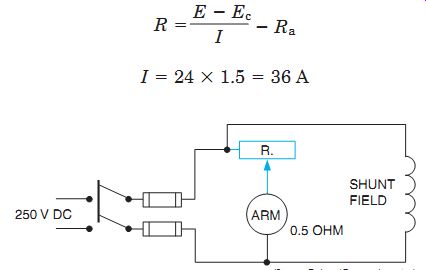AMAZON multi-meters discounts AMAZON oscilloscope discounts
Goals:
- List the two factors that limit the current taken by a motor armature.
- Explain why it's necessary to insert resistance in the proper part of a DC motor circuit on starting.
- Calculate the amount of series resistance required for a DC motor at different speeds during the starting period.
The starting of fairly large DC motors requires that current be increased gradually or that resistance be inserted in series with the armature of the motor.
Two factors that limit the current taken by a motor armature from a given line are the counter emf and the armature resistance. When the motor is at a standstill, there is no counter emf, nor is there inductive reactance such as in an AC motor. Therefore, the current taken by the armature will be abnormally high unless the DC supply is increased gradually, as with solid-state equipment, or an external current limiting resistor is used.
ill. 1 illustrates a shunt motor connected directly across a 250-volt line. The resistance of the armature is 0.5 ohm. The full-load current taken by the motor is 25 amperes and the shunt field current is 1 ampere. The resulting armature current at full load is 24 amperes.
The counter emf developed by a motor is proportional to the speed of the motor if the field is constant. In addition, the counter emf equals the applied voltage minus the armature (IR) drop. The current through the armature can be found using Ohm's law as follows:
where: I = armature current, amperes E = line voltage, volts Ec = counter emf, volts Ra = armature resistance, ohms

ill. 1 This 25-ampere DC motor will draw 500 amperes from the line on starting
without armature resistance.
When there is no starting resistance in the circuit, the current through the armature at the instant of starting, for the shunt motor in […]
This starting current is undesirably high. The total starting current is equal to the armature current plus the field current of 1 ampere. The ratio of the starting current to the full-load current is
The excessive torque and heat produced by this current may harm the motor and the load attached to it. In addition, it may cause the insulation to overheat on starting and the burning of the armature.
These effects can be eliminated by connecting a resistance in series with the armature, ill. 2. The resistance reduces the starting armature current to approximately 1.5 times the full-load current value. The resistance is then gradually removed from the circuit.
The value of this series resistance is determined by solving the previous equation for R.
Remember that the armature resistance (Ra) must be subtracted:

ill. 2 Starting resistors are used to eliminate high starting currents.
When the motor is at a standstill, the series resistance is equal to: _ 0.5 _ 6.44 ohms
Resistors are also rated in watts. The following formula can be used to find the power requirement of the resistor:
I2 x R = P
36 _ 36 x 6.44 _ 8346 watts
The proper resistor can be selected by knowing the required resistance and the power value in watts.
The required series resistance can be determined for some intermediate speed in the starting period of the motor. In this case, solve for the counter emf at the speed in question and then obtain the resistance from the formula given. Because the counter emf differs from the applied voltage only by the armature (IR) drop, the speed is nearly proportional to the applied voltage. E.g., at half speed, the counter emf is equal to
QUIZ
1. Why is a starter necessary on a DC motor?
2. Why is a resistance placed in series with the armature only rather than in series with the entire shunt motor?
3. If an armature has a resistance of 0.5 ohm, what series resistance must be used to limit the current to 30 amperes across a 230-volt circuit at the instant of starting? What is the power rating?
4. What resistance must be used when the motor in question 3 reaches 50 percent of its rated speed?